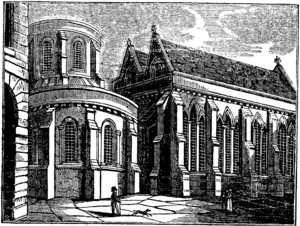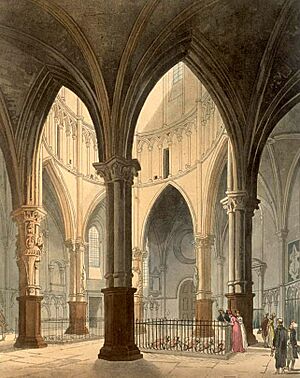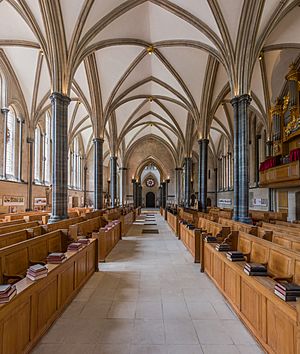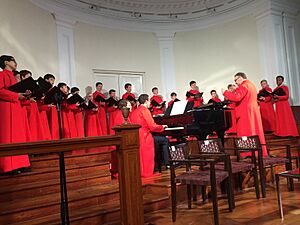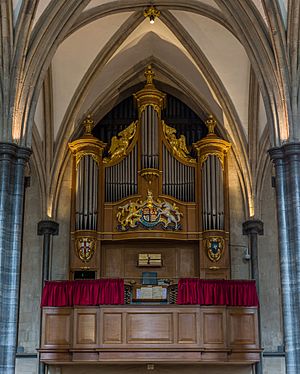Temple Church facts for kids
Quick facts for kids Temple Church |
|
|---|---|
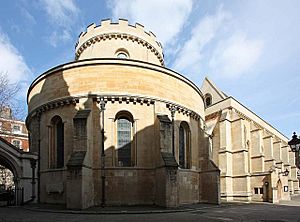
Temple Church, view from south-west, showing the original Round Church, now forming the narthex
|
|
| Location | London, EC4 |
| Denomination | Church of England |
| Previous denomination | Roman Catholic |
| Churchmanship | Book of Common Prayer |
| History | |
| Consecrated | 10 February 1185 |
| Architecture | |
| Functional status | Active |
| Administration | |
| Deanery | City |
| Diocese | London |
The Temple Church is a historic church in London, England. It was built by the Knights Templar, a famous group of warrior monks, as their main base in England. The church is located between Fleet Street and the River Thames. It was officially opened on February 10, 1185.
The Temple Church is special because it has a unique round shape, which was common for Knights Templar churches. It is also known for its old stone statues, called effigies, from the 1200s and 1300s. During the time of King John, the church even served as the royal treasury, like a bank for the king!
Today, the church is owned by two legal societies, the Inner Temple and Middle Temple. These are important places where lawyers in England learn and work. The church was badly damaged during World War II but has been carefully rebuilt and restored. The area around the church is still called "the Temple."
Contents
History of the Temple Church
Building the Church
In the mid-1100s, the Knights Templar in London needed a bigger place. Their first meeting spot was too small for their growing group. So, they bought the land where the Temple Church stands today. They planned to build a large complex with homes, training areas, and recreation spots for their members.
The church has two main parts. The first part is the original round building, called the Round Church. This part now acts as the main area where people sit, known as the nave. The second part is a rectangular section added later, about 50 years after the first part. This section is called the chancel and is at the east end of the church.
The Knights Templar designed their churches, like the Temple Church, to look similar to famous holy places in Jerusalem. They were inspired by the Dome of the Rock and the Church of the Holy Sepulchre. The Round Church is about 55 feet (16.7 meters) wide. Inside, it has columns made of a special stone called Purbeck Marble. These are some of the oldest known free-standing columns of this type.
The church was officially opened on February 10, 1185, by a religious leader from Jerusalem named Heraclius. It is believed that King Henry II was there for this important event.
The Knights Templar's Influence
The Knights Templar were very powerful in England. The leader of the Temple even had a seat in parliament. Kings and important church leaders often stayed at the Temple complex. The Knights Templar also acted like an early bank, keeping money safe for nobles. Sometimes, they even protected this money from the king!
Their great wealth and independent network across Europe made some kings jealous. Many historians believe this jealousy eventually led to the Knights Templar's downfall.
In 1215, a famous meeting happened at the Temple Church. William Marshal helped negotiate between King John and his nobles. The nobles wanted the king to respect their rights. This meeting led to the signing of the Magna Carta in June of that year, a very important document in English history.
Later, King Henry III wanted to be buried in the church. To make space, the original chancel was taken down, and a new, larger one was built. This new chancel was finished in 1240. Although one of Henry's sons was buried there, Henry himself later chose to be buried in Westminster Abbey.
After the Knights Templar
In 1307, the Knights Templar were disbanded. King Edward II took control of the church. Later, it was given to another group of knights, the Knights Hospitaller. They rented out parts of the Temple to two groups of lawyers. These groups eventually became the Inner Temple and the Middle Temple, which are still important legal societies today. They share the church for their ceremonies.
From the 1500s to the 1900s
In 1540, the church became the property of the Crown again when King Henry VIII took over the Knights Hospitaller's property. King Henry appointed a priest for the church, called the "Master of the Temple."
In the 1580s, the church was a place of debate between different religious groups. The famous writer Shakespeare knew the church well. He even used the church and its garden as a setting in his play Henry VI, part 1. In the play, a fictional scene takes place where two roses, one white and one red, are picked, symbolizing the start of the Wars of the Roses. In 2002, new white and red roses were planted in the gardens to remember this story.
In 1608, King James I agreed that the two legal societies could use the church forever, as long as they took care of it. They still do today.
The church survived the Great Fire of London in 1666. However, it was updated by Christopher Wren, a famous architect. He added an altar screen and the church's first organ. In the 1800s, the church was restored again, with walls and ceilings decorated in a style that tried to look like the original church.
The Twentieth Century
On May 10, 1941, during World War II, German bombs hit the Temple Church. The roof of the Round Church caught fire, and the fire spread. The organ and all the wooden parts of the church were destroyed. The marble columns in the chancel cracked from the intense heat. These columns were later replaced with new ones that looked exactly like the originals.
The church was rebuilt and reopened in November 1958. It was recognized as a Grade I listed building in 1950, meaning it is a very important historic site.
What the Church is Used For
In the past, the Temple Church was used for special ceremonies where new Knights Templar joined the order. These ceremonies were secret. Today, the Temple Church holds regular church services, including Holy Communion and morning prayers on Sundays. It also hosts weddings, but only for members of the Inner and Middle Temples.
The Temple Church is a "royal peculiar" church. This means it is directly under the authority of the Crown, not a bishop. This is why the choir members wear special scarlet robes.
Music at the Temple Church
The church is famous for its music, with regular choir performances and organ concerts. A choir was started at the Temple Church in 1842 and quickly became well-known.
In 1927, the Temple Choir, led by George Thalben-Ball, became world-famous. They recorded Mendelssohn's Hear My Prayer, which included a solo by Ernest Lough. This recording sold millions of copies and is one of the most popular church choir recordings ever.
The church's excellent sound quality has also attracted famous musicians. Sir John Barbirolli recorded a well-known performance of Fantasia on a Theme by Thomas Tallis there in 1962. Paul Tortelier also recorded the complete Bach Cello Suites at the church in 1982.
In 2003, the church was used for a music video by the choir Libera.
When composing the music for the movie Interstellar, Hans Zimmer chose the Temple Church to record the organ parts. The church's former organist, Roger Sayer, played the organ. Zimmer said that "Setting foot into Temple Church is like stepping into profound history. ...Temple Church houses one of the most magnificent organs in the world."
The choir still records, broadcasts, and performs today. It is an all-male choir with 18 boys who receive scholarships for their education, and 12 professional men. They perform weekly at Sunday services. In 2003, the choir performed Sir John Tavener's long piece The Veil of the Temple over seven hours.
Organs at the Church
The Temple Church has two organs. One is a smaller chamber organ built in 2001. The other is a large, four-manual Harrison & Harrison organ. This organ was originally built in 1924 for a private house and was moved to the Temple Church in 1954.
Famous Organists
Many famous organists have played at the Temple Church, including:
- Francis Pigott (1688–1704)
- John Stanley (1734–1786)
- Dr Edward John Hopkins (1843–1897)
- Sir Henry Walford Davies (1897–1923)
- Sir George Thalben-Ball (1923–1982)
- Roger Sayer (2014–2023)
- Thomas Allery (2023-present)
Master of the Temple
The Temple Church always has two clergy members: the "Master of the Temple" and the "Reader of the Temple." The title "Master of the Temple" comes from the original leader of the Knights Templar. The Master is chosen by the Crown. The current Master of the Temple is the Reverend Robin Griffith-Jones, who was appointed in 1999. He often gives talks that are open to the public.
The Master's official home is the Master's House, a historic house built next to the church in 1764.
People Buried in the Church
Many important people are buried in the Temple Church, including:
- William Marshal, 1st Earl of Pembroke (died 1219), a famous knight and regent of England.
- William Marshal, 2nd Earl of Pembroke (died 1231), his son.
- Gilbert Marshal, 4th Earl of Pembroke (died 1241), another of his sons.
- Robert de Ros (died around 1227), a noble who signed the Magna Carta.
- John Selden (died 1654), a famous English lawyer and scholar.
- Oliver Goldsmith (died 1774), a well-known writer, poet, and playwright.
Images for kids
See also
 In Spanish: Iglesia del Temple (Londres) para niños
In Spanish: Iglesia del Temple (Londres) para niños


